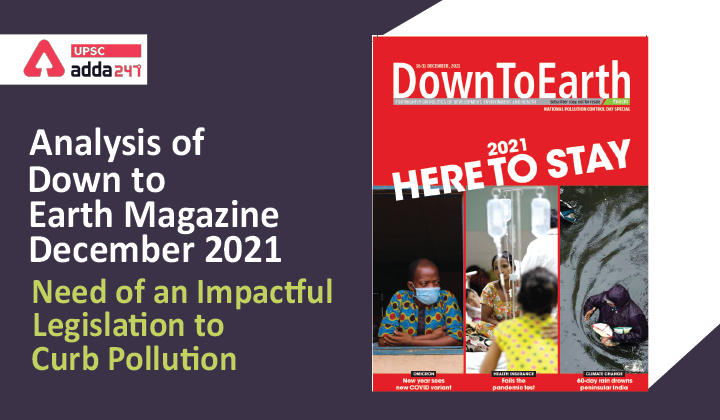Table of Contents
Context
- Members of Parliament have raised at least 368 questions on air pollution in the country between 2000-2019; 200 of which were after 2016.
- So it is only recently that the country’s political and legislative system has acknowledged the gravity of this crisis.
- The 2019 Winter Session of Parliament saw air pollution highlighted in both the Houses, accounting for nearly 11 hours of discussions. However, the growing interest in the matter is yet to translate into meaningful legislative action.
How serious is the problem of Air Pollution for the country?
- 1.2 million Indians died in 2019 from exposure to air pollution.
- It has been 3 decades since the last amendment to national laws addressing air pollution.
- 72 MPs from 16 states discussed air pollution in both the Houses in the 2019 Winter Session of Parliament.
- 58 MPs in both Houses focused on increased winter air pollution in Delhi and the National Capital Region.
Problem areas in air quality governance
- Insufficient legal enforcement of mitigation measures.
- Inadequate policies and institutions.
- Financial and technological gaps.
- Unconstructive or non-existent political dialogue.
- Lack of public awareness.
No Concrete law framed by Parliament
Outdated Laws
The three laws pertaining to air quality governance—the Water (Prevention and Control of Pollution) Act, 1974; the
Air (Prevention and Control of Pollution) Act, 1981 (also called “the Air Act”); and the Environment (Protection) Act, 1986—have seen little change since enforcement. The last amendment was the Air Act in 1987.
Repeated Ordinances
The Centre passed an Ordinance in October 2020 setting up a new Commission on Air Quality Management in Delhi and
the NCR. It lapsed and was promulgated again in March 2021. It was replaced with a Bill that passed in both Houses in August 2021.
Big Declarations
The Union finance minister said in the budget speech for 2020-21 that grants would be allocated to cities taking measures to ensure cleaner air, which the Centre has initiated. During his Independence Day address in 2020, the Prime Minister announced a new mission on air quality, but no measures have been taken.
The legal and regulatory framework for Pollution Control in India
- Water (Prevention and Control of Pollution) Act, 1974
- Water (Prevention and Control of Pollution) Cess Act, 1977
- Air (Prevention and Control of Pollution) Act, 1981
- The Air (Prevention and Control of Pollution) Rules formulated in 1982
- Environment (Protection) Act, 1986 (EPA)
Some regulatory measures are taken by the Central Government for the prevention, control and abatement of air pollution in the country
National Clean Air Programme (NCAP) – It runs under the Central Sector “Control of Pollution” Scheme as a long-term, time-bound, national-level strategy to tackle the air pollution problem across the country in a comprehensive manner with targets to achieve 20 % to 30 % reduction in PM10 and PM2.5 concentrations by 2024 keeping 2017 as the base year for the comparison of concentration.
Comprehensive Action Plan (CAP) – Launched in 2018 identifying timelines and implementing agencies for actions identified for prevention, control and mitigation of air pollution in Delhi and NCR.
Graded Response Action Plan (GRAP) – It was notified on January 12, 2017, for prevention, control and abatement of air pollution in Delhi and NCR. It identifies graded measures and implementing agencies for response to four AQI categories, namely, Moderate to Poor, Very Poor, Severe and Severe + or Emergency.
SAMEER app – It has been launched wherein air quality information is available to the public along with provision for registering complaints against air polluting activities.
Why does India Need a Stringent Law for curbing air pollution?
- A UNEP study revealed that 1 in 3 countries do not have legally mandated air quality standards and despite the greater attention on air pollution, India is also among those countries that are yet to see any major legislative impact on the ground.
Legislation can enable citizens to hold government institutions responsible for air quality. - It can also establish processes for monitoring, enforcement, and public participation in air quality control which could have significant impacts on improving air quality.
- Present air quality standards in national laws of the country do not comply with the WHO air quality guidelines.
- With the new law, we should set requirements for institutional responsibility, monitoring, accountability, planning and sanctions, as well as public participation and human rights.
- UNEP and other stakeholders have been advocating for the shift from a carbon-based to a green economy. India also needs to move in that direction.
Conclusion
Air pollution kills 7 million people a year, more than COVID-19 and according to several studies, air pollution may reduce the life expectancy of Indians by nine years. To tackle this situation, we need to act fast and together. Strengthening air quality laws and regulations is one key policy action to significantly improve air quality.



 TSPSC Group 1 Question Paper 2024, Downl...
TSPSC Group 1 Question Paper 2024, Downl...
 TSPSC Group 1 Answer key 2024 Out, Downl...
TSPSC Group 1 Answer key 2024 Out, Downl...
 UPSC Prelims 2024 Question Paper, Downlo...
UPSC Prelims 2024 Question Paper, Downlo...




